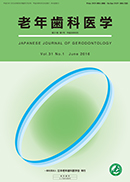Volume 36, Issue 3
Displaying 1-13 of 13 articles from this issue
- |<
- <
- 1
- >
- >|
Statements
-
2021Volume 36Issue 3 Pages 206
Published: December 31, 2021
Released on J-STAGE: January 28, 2022
Download PDF (111K) -
2021Volume 36Issue 3 Pages 207
Published: December 31, 2021
Released on J-STAGE: January 28, 2022
Download PDF (157K)
Review Articles
-
2021Volume 36Issue 3 Pages 208-
Published: December 31, 2021
Released on J-STAGE: January 28, 2022
Download PDF (103K) -
2021Volume 36Issue 3 Pages 209-212
Published: December 31, 2021
Released on J-STAGE: January 28, 2022
Download PDF (1992K) -
2021Volume 36Issue 3 Pages 213-216
Published: December 31, 2021
Released on J-STAGE: January 28, 2022
Download PDF (594K) -
2021Volume 36Issue 3 Pages 217-219
Published: December 31, 2021
Released on J-STAGE: January 28, 2022
Download PDF (730K)
Original Articles
-
2021Volume 36Issue 3 Pages 220-226
Published: December 31, 2021
Released on J-STAGE: January 28, 2022
Download PDF (1120K) -
2021Volume 36Issue 3 Pages 227-238
Published: December 31, 2021
Released on J-STAGE: January 28, 2022
Download PDF (1504K)
Clinical Reports
-
2021Volume 36Issue 3 Pages 239-248
Published: December 31, 2021
Released on J-STAGE: January 28, 2022
Download PDF (4253K) -
2021Volume 36Issue 3 Pages 249-255
Published: December 31, 2021
Released on J-STAGE: January 28, 2022
Download PDF (2130K)
Report on Survey
-
2021Volume 36Issue 3 Pages 256-262
Published: December 31, 2021
Released on J-STAGE: January 28, 2022
Download PDF (1860K)
Topics
-
2021Volume 36Issue 3 Pages 263-268
Published: December 31, 2021
Released on J-STAGE: January 28, 2022
Download PDF (2782K)
Article Retraction
-
2021Volume 36Issue 3 Pages 276
Published: December 31, 2021
Released on J-STAGE: January 28, 2022
Download PDF (61K)
- |<
- <
- 1
- >
- >|
